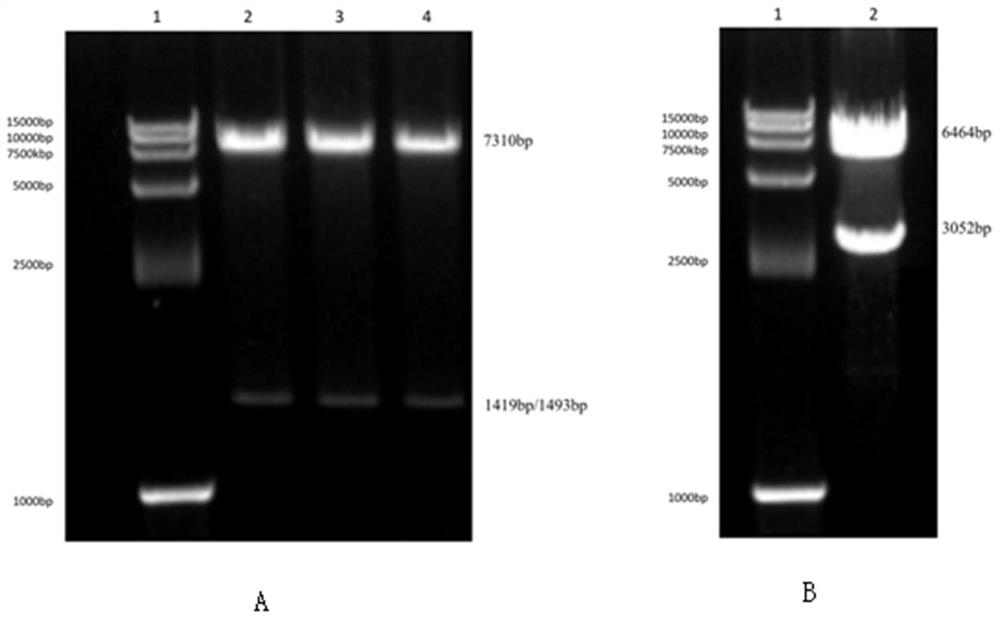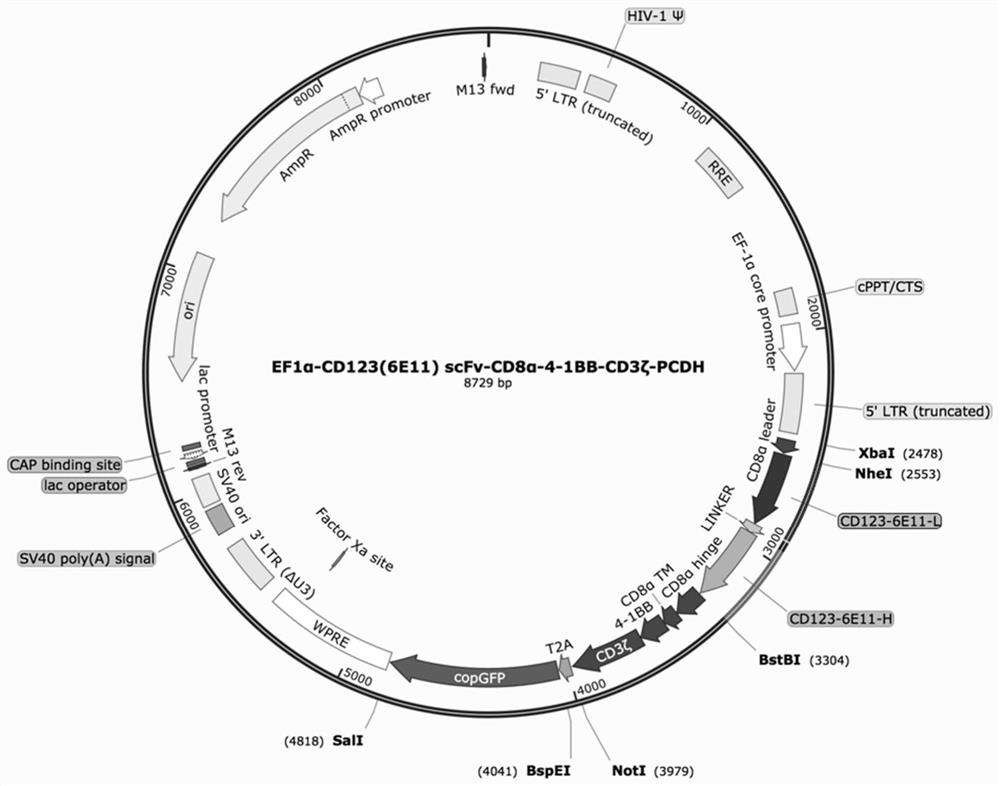CD123-targeted chimeric antigen receptors and dual-target chimeric antigen receptors containing CD123-targeted chimeric antigen receptors
A chimeric antigen receptor and targeting technology, applied in the field of biomedicine, can solve the problems of poor curative effect, easy recurrence and ineffectiveness
- Summary
- Abstract
- Description
- Claims
- Application Information
AI Technical Summary
Problems solved by technology
Method used
Image
Examples
Embodiment 1
[0139] Example 1: Construction of Chimeric Antigen Receptor CD123 scFv-CD8α-4-1BB-CD3ζ Vector 1. Using Nhe I and Bstb I endonucleases to digest the CD8α-4-1BB-CD3ζ fragment constructed by the inventors earlier , the CD8α-4-1BB-CD3ζ fragment was obtained, and its amino acid sequence is shown in SEQ ID NO.18. The plasmid containing the CD8α-4-1BB-CD3ζ fragment can be prepared by any suitable method in the prior art, for example, the method in the patent No. ZL201510233748.0.
[0140] 2. The 6E11 CD123 scFv, 12H7 CD123 scFv, and 13C3 CD123 scFv fragments obtained by whole gene synthesis were connected to the target vector, and the constructed 6E11-CD123 scFv-CD8α-4-1BB-CD3ζCAR (6E11 123CAR), 12H7-CD123 scFv- CD8α-4-1BB-CD3ζCAR (12H7 123CAR), 13C3-CD123 scFv-CD8α-4-1BB-CD3ζCAR (13C3 123CAR) target vectors were digested with endonucleases Nhe I and Not I, and the results were as follows figure 1 As shown in A, the results of enzyme digestion showed that the positive clones contai...
Embodiment 2
[0141] Example 2: Preparation of chimeric antigen receptor CD123 scFv-CD8α-4-1BB-CD3ζ lentivirus-modified T cells
[0142] 1. The CD123 scFv-CD8α-4-1BB-CD3ζ expression plasmid and the packaging plasmids psPAX2 and pMD.2G were extracted with EndoFree Plasmid Maxi Plasmid Extraction Kit (QIAGEN Company). The three plasmids were transfected with PEI transfection reagent (polyscience company) in a ratio of 4:3:1 (see the instruction manual of PEI transfection reagent for specific methods). The fresh culture medium was replaced 12 hours after transfection, and the virus supernatant was collected 24 hours and 48 hours later, centrifuged at 4°C, 3000 rpm for 15 minutes, filtered through a 0.45 μm filter, and then ultracentrifuged at 50,000 g at 4°C for 1.5 hours. Concentrate 10 times and store at -80°C.
[0143] 2. Preparation of T cells: Take 10 ml of fresh healthy human peripheral blood, and use RosetteSep T cell enrichment Cocktail (Stemcell Company) and Ficoll-Paque PLUS (GE Hea...
Embodiment 3
[0146] Example 3: Killing effect of chimeric antigen receptor CD123 scFv-CD8α-4-1BB-CD3ζ lentivirus-modified T cells on leukemia cells
[0147] 1. Expression levels of CD123 in hematological tumor cell lines:
[0148] Both MV4-11 and K562 cell lines were purchased from ATCC, USA. After culturing separately, each pipette 5 × 10 5 The cell suspension was washed twice with PBS, labeled with APC anti-human CD123 monoclonal antibody (Biolegend Company), with labeled APC-isotype as the control group, and incubated on ice for 30 minutes. The expression levels of CD123 in various cell lines were detected by flow cytometry, and the results were as follows Figure 7 As indicated, MV4-11 are CD123 positive cells and K562 cells are CD123 negative cells.
[0149] 2. Flow cytometry of residual tumor cells after co-culture of CAR-modified T cells with MV4-11 and K562 cell lines:
[0150] Press the above cells into 2 × 10 5 Cells / well were seeded into 24-well culture plates, and 2.5×10 ...
PUM
 Login to View More
Login to View More Abstract
Description
Claims
Application Information
 Login to View More
Login to View More - R&D
- Intellectual Property
- Life Sciences
- Materials
- Tech Scout
- Unparalleled Data Quality
- Higher Quality Content
- 60% Fewer Hallucinations
Browse by: Latest US Patents, China's latest patents, Technical Efficacy Thesaurus, Application Domain, Technology Topic, Popular Technical Reports.
© 2025 PatSnap. All rights reserved.Legal|Privacy policy|Modern Slavery Act Transparency Statement|Sitemap|About US| Contact US: help@patsnap.com



